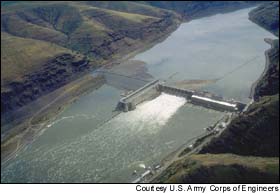forum
library
tutorial
contact

U.S. Says 4 Lower Snake River Dams Will Stay
Spencer SwartzEnvironmental News Network - July 28, 2000
|
the film forum library tutorial contact |

|
U.S. Says 4 Lower Snake River Dams Will StaySpencer SwartzEnvironmental News Network - July 28, 2000 |
 After months of
delay, two federal
reports issued
Thursday said that
while four hydro
electric dams in
the Pacific
Northwest have
played a key role
in the decline of
12 salmon
species, they will
not be removed,
for now.
After months of
delay, two federal
reports issued
Thursday said that
while four hydro
electric dams in
the Pacific
Northwest have
played a key role
in the decline of
12 salmon
species, they will
not be removed,
for now.
"Science shows that taking down the dams would be the most beneficial remedy ... but there is no single solution to recovering these fish," said George Frampton, chairman of the White House Council on Environmental Quality, at a news conference in Portland, Oregon.
"This effort is a comprehensive approach that requires the efforts of Congress, the Northwestern states, federal agencies, and Indian tribes that looks at the hydro-front, the harvest front, water quality, and other areas (to recover the fish)," he said.
In the first report, the National Marine Fisheries Service (NMFS) outlined legally binding guidelines for all 29 federal dams in the Northwest, including the four in dispute: Lower Granite, Lower Monumental, Little Goose, and Ice Harbor.
The second report, based on studies by the NMFS and eight other federal agencies, made non-binding recommendations to help salmon recovery efforts throughout the Columbia and Snake river basins, an area that extends into six states and Canada.
Under the binding guidelines, salmon recovery efforts will address issues like improving water quality, overhauling a federal fish hatcheries program to minimize harm to wild salmon, maintaining ceilings on fish harvests, and improving fish passage through dams.
The efforts to recover the salmon, Frampton said, will be subjected to rigorous performance standards each year monitoring the health of the salmon populations. The programs will also be examined after five, eight, and 10 years.
Frampton, however, said that if fish populations show further declines during recovery efforts, "then be reassured we will come back to dam-breaching".
The decision to keep the dams standing for the moment is a blow to environmentalist groups and Indian tribes, who claim the best way to speed the salmon's recovery is to remove the dams.
 Chris Zimmer,
spokesman for
Save the Salmon,
said the recovery
guidelines were
vague and
unlikely to lead to
reviving salmon
populations.
Chris Zimmer,
spokesman for
Save the Salmon,
said the recovery
guidelines were
vague and
unlikely to lead to
reviving salmon
populations.
"We were hoping to see more detailed provisions, but we didn't get it," Zimmer said. "For example, what is going to actually trigger a government response to take the dams down if salmon populations continue to decline? We don't know."
Zimmer also said lawsuits were a "strong potential" now that dam-breaching advocates could measure how well the provisions outlined today accord with the Clean Water and Endangered Species Acts.
The 12 salmon species, protected under the Endangered Species Act, have been in rapid decline over the years due to the effects of the dams, logging, mining, and overfishing.
Thursday's official announcement to keep the dams in place for now was not unexpected, after The White House released copies last week of testimony Frampton was to have given a congressional subcommittee saying no recommendation would be made to remove them.
Frampton also said an impediment to dam-removal is the length of time it would take to move through Congress, which will make any final decision.
There is also little support in Congress or from policymakers in the Northwest to remove the dams.
The number of salmon returning from the sea to spawn each year in the Northwest has declined from an estimated stock of 10 to 16 million a century ago to about 1 million today.
But the dams, among some of the biggest structures in the world, also help power cities from Seattle to Los Angeles, and support much of the region's economy.
They are also used to irrigate approximately 37,000 acres of farmland in eastern Washington, and carry barges loaded with grain and other commodities shipped out of southern Idaho.
The Snake River dams have also emerged as an issue in the presidential campaign. Republican presidential candidate George W. Bush says the dams should stay, while his Democratic opponent, Vice President Al Gore, has not taken a stand on the issue.
learn more on topics covered in the film
see the video
read the script
learn the songs
discussion forum